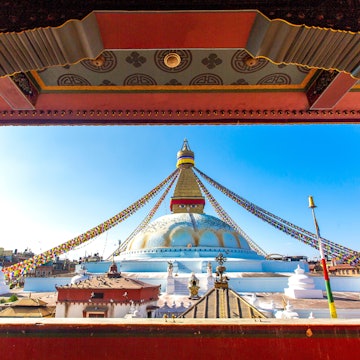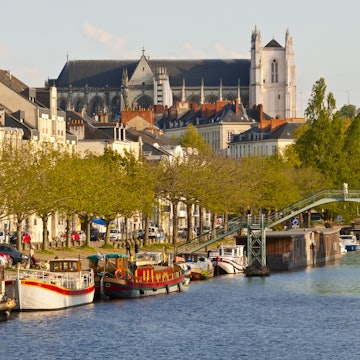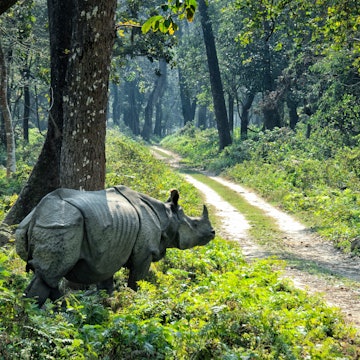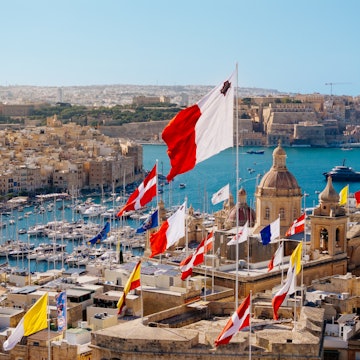
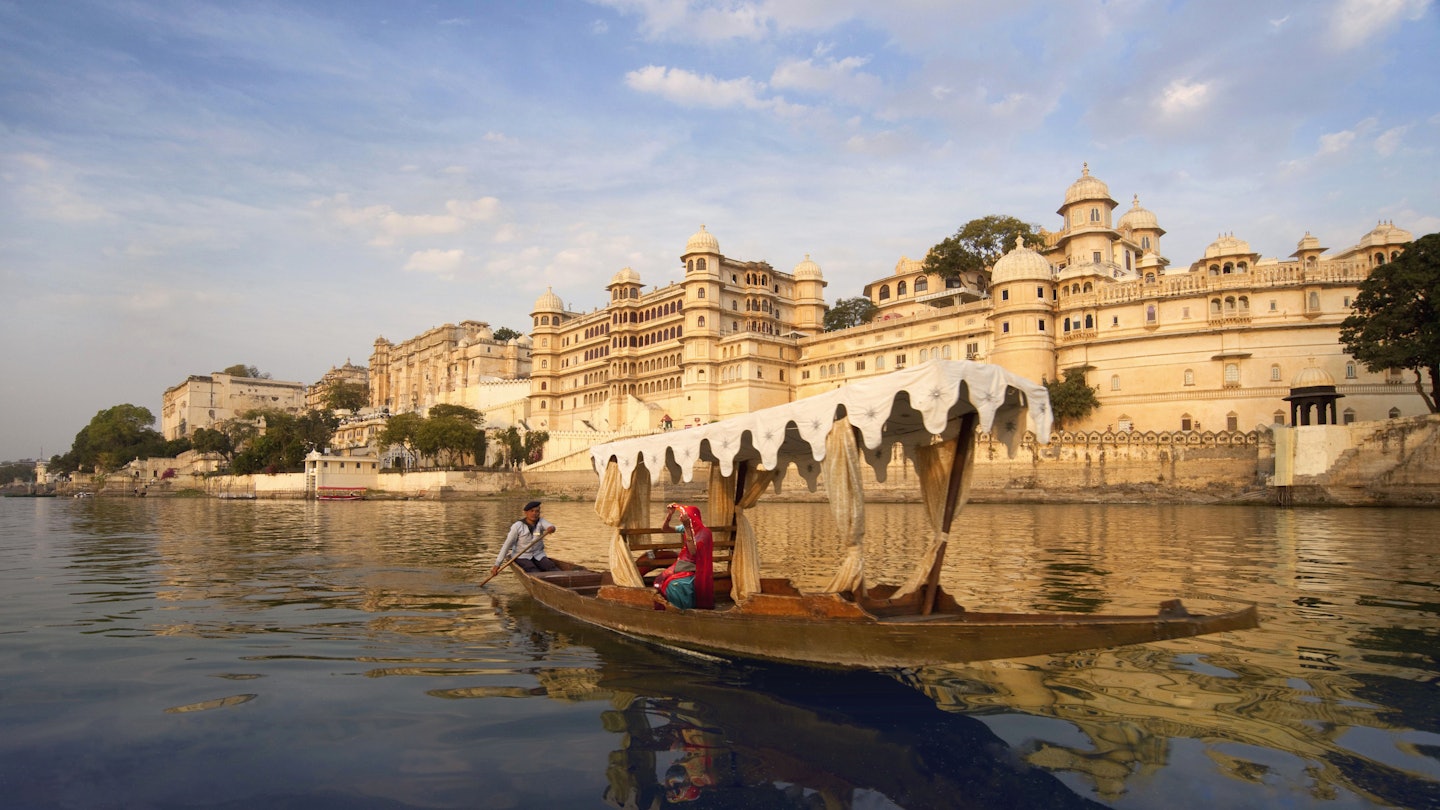
Udaipur's City Palace is Rajasthan's largest royal residence. Pete Seaward for Lonely Planet
Extravagant royal palaces seem to pop up on every street corner in Rajasthan, but the City Palace in Udaipur is perhaps the grandest of them all. It’s certainly the largest, taking up half a kilometer of the lakeshore in the center of Rajasthan’s legendary White City.
Crowned by a fabulous collection of turrets, terraces and domes, this gleaming, creamy white palace dominates the eastern bank of Lake Pichola, the royal reservoir carved out of the desert by the rulers of the Mewar Kingdom in the 14th century.
Maharana Udai Singh II founded the City Palace two centuries later, filling its courtyards and palaces with murals, mirrored mosaics and carved marble. It still serves as a residence for the Mewar royal family, but several wings are open to visitors as part of the City Palace Museum.
Even by the lavish standards of India, the treasures of the Mewar rulers are truly something to behold. Here’s everything you need to know about visiting Udaipur’s City Palace.
What’s the history of Jaipur’s City Palace?
The House of Mewar, Udaipur’s ruling clan, is the oldest serving dynasty in the world, founded by the Rajput warrior Bappa Rawal in the 7th century. Its maharanas (princely rulers) were responsible for building most of Udaipur’s monuments, and they were also pivotal in limiting – temporarily, at least – the expansion of the Mughal empire.
The City Palace was founded by Maharana Udai Singh II in the 1550s, after a chance meeting with a sage who advised him to build a city here, but the complex was expanded and remodelled repeatedly over the following centuries.
Udaipur became Mewar’s power base after the capture of Chittorgarh in 1568, and Maharana Pratap famously held back the vast armies of Akbar at Haldighati in 1576 before the Mewars and Mughals finally agreed a peace treaty in 1615.
Most people associate Mewar with the Sisodia family, who ruled the kingdom from the 14th century to the present day. The current head of the House of Mewar, Dr Lakshyaraj Singh Mewar, is a successful tourism entrepreneur and holder of seven Guinness World Records for his charitable, social and environmental work.
When should I go to the City Palace?
Try to enter as soon as possible after the palace gates open at 9am – the crowds swell quickly, and the crush of visitors can make it difficult to stop and study the exhibits in some parts of the museum. The palace stays busy right up until closing time at 5:30pm.
The best time to visit Udaipur’s City Palace is just after the rainy monsoon, from October to November, when the skies are clear and sunny. The weather stays mostly dry until March, but mornings and evenings can be chilly from December to February. It’s best to avoid Rajasthan in April and May, when temperatures can soar above 33°C (91°F).

How much time should I spend at the City Palace?
You’ll need at least half a day to explore the City Palace, or a full day if you also plan to visit associated sights such as the Crystal Gallery and Vintage & Classic Car Collection and also take the boat trip to Jagmandir Island.
If you stay anywhere close to Lake Pichola, you can reach the palace easily on foot – taxis are not permitted to enter the historic center of Udaipur during the day, and autorickshaws can only navigate certain streets (and often get stuck in autorickshaw jams).
What’s the best way to see the City Palace?
The City Palace is a maze of interlinked courtyards and palaces, but navigating is fairly straightforward as visitors follow a linear route through the complex. You’ll start and end at Manek Chowk, which you can enter from the north via the Badi Pol gate, or from the south via the Sheetla Mata gate.
Official guides can be arranged at the palace ticket desks, and it’s definitely helpful to have a detailed commentary while exploring this vast residence. If you’d rather explore at your own pace, audio guides are available in Hindi, English, French, German and Spanish for an extra ₹200 (US$2.35).
How much do tickets cost?
Tour agencies can make bookings, but it’s just as easy to buy tickets on arrival at the Badi Pol or Sheetla Mata gates. Entry costs ₹400 (US$4.70) for adults, or ₹150 (US$1.75) for children, and entry is free for the under-fives and people with disabilities.
There’s also a ₹50 (US$0.60) entry fee to enter the palace compound, a ₹50 (US$0.60) fee for the Government Museum, a ₹500 (US$5.90) fee for the Crystal Gallery, and a ₹330 (US$3.90) fee for the Vintage & Classic Car Collection.
What should I eat and drink at the City Palace?
With the downtown location, many of Udaipur’s best restaurants are close at hand in the Lal Ghat area, or across Lake Pichola at Hanuman Ghat. However, the palace is so vast that you may prefer to spend the whole day inside the compound.
Filling set meals of dhal bhatti churma (Rajasthani-style wheat rolls with lentil curry) are served at the museum restaurant in the Zenana Mahal, and at higher prices at the museum restaurant in Manek Chowk. For something more upmarket, enjoy spectacular Indian gastronomy with lake views at Sunset Terrace, the restaurant at the Taj Fateh Prakash Palace hotel.

What are the City Palace’s must-sees?
Rajasthan’s largest palace is a sprawling maze with a massive floorplan. To make the most of your time, enter via the northern Badi Pol gate and exit via the southern Sheetla Mata gate, also visiting the Crystal Gallery, Jagmandir Island and the Vintage & Classic Car Collection just east of the palace grounds.
Manek Chowk
Whichever gate you enter through, you’ll emerge into the huge open courtyard known as Manek Chowk, once the setting for royal elephant fights. Near the Badi Pol, look out for the eight arches just outside the Tripolia Gate, commemorating the eight times the maharanas were weighed and their weight in treasure distributed to the populace.
Beside the main courtyard are giant, mousetrap-like devices used to catch tigers and leopards. A fun sound-and-light show takes place in Manek Chowk in the evenings, telling the story of the fort – check timings locally as the show is sometimes paused. During Holi, the courtyard hosts a massive ceremonial bonfire and processions attended by the Mewar royal family.
City Palace Museum
The City Palace Museum covers the heart of the palace, centered on the Rai Angan (Royal Courtyard), where Maharana Udai Singh II met the sage who told him to build the city of Udaipur. Note the sun-topped royal crest of Mewar as you pass through the Darikhana ki Pol gate to enter the museum.
The Armoury
Bear right as you enter to reach the astonishing armory, full of whistle-tooting guards trying desperately to keep the crowds in order. You find everything from chain mail trousers to swords, battleaxes, warhammers, flintlock rifles, spears, shields and katar punch daggers – almost all of them lavishly inlaid and engraved. Look out for the crescent-shaped arrows designed to maximize injuries – a gruesome tool in the medieval Rajput arsenal.

Ganesh Chowk & Government Museum
Moving beyond the armory, you’ll pass into open Ganesh Chowk, with a gateway leading on to the often overlooked Government Museum, accessed on a separate ticket. The museum’s dusty collection includes ivory models, carved temple deities, moth-eaten taxidermy, jewel-like miniature paintings from the Mewar School, regal portraits of maharanas with twirly mustaches, and a collection of turbans, including one worn by Shah Jahan, creator of the Taj Mahal.
Rai Angan
Passing through the mirror-mosaic-covered Ganesh Deodi hall, you’ll reach the chequerboard-paved Rai Angan (Royal Courtyard). Rooms along one side contain historical paintings, including several of the Battle of Haldighati (1576), where Mewar forces gallantly fought the army of the Mughal emperor Akbar. Look out for the bowl of genuine Haldighati battlefield dirt.
The Royal Apartments
Continue through a chain of apartments reserved for the royal household. Of particular note are the Baadi Mahal from 1699, ringed by open pavilions containing fountains and colorful stained glass, and the Kishan Vilas, with intricate miniature paintings from the time of Maharana Bhim Singh (r 1778–1828).
Executed in a Mewar-meets-baroque style, the turquoise Bhim Vilas is one of the most beautiful spaces in all of Rajasthan. Note the ornate arched doorways and royal swing-seat, and the lace-like patterns painted on the ceilings.

Mor Chowk & Surya Choupad
A sequence of mirror- and painting-adorned chambers leads on to the achingly beautiful courtyard known as Mor Chowk – with its gasp-inducing mosaics of peacocks, flowers and maharanas – and the mural-filled Surya Choupad, dominated by a huge metal mask of Surya, patron deity of the Mewar dynasty.
Zenana Mahal
The southern end of the museum comprises the 17th-century Zenana Mahal, the royal ladies’ quarters. Devote some time to the interesting displays on life in the women’s quarters, the collection of ornately decorated musical instruments, and the brilliant Picturing Place exhibition, exploring Udaipur’s long history using paintings and old maps.
The palace’s central courtyard, Laxmi Chowk, contains a beautiful white pavilion and displays of royal outfits, howdahs (elephant saddles), palanquins and other posh people carriers. This is also where you’ll find the more budget-friendly of the palace’s two restaurants.
Crystal Gallery
Inside the City Palace compound, south of Manek Chowk near the Fateh Prakash Palace Hotel, the Crystal Gallery displays an extravagant collection of crystal-handled cutlery and place settings, chandeliers, crystal-framed chairs and even a crystal bed.
Maharana Sajjan Singh placed a massive order with English crystal maker F&C Osler & Co in 1877, but he died before it arrived, so the delivery was packed away, unopened, for 110 years. You’ll need to leave cameras and phones with the guard.
The relatively hefty admission fee also includes entry to the downstairs Durbar Hall – a lavish space full of weaponry, royal portraits and dangling chandeliers. You can visit both without entering the City Palace Museum, but you'll have to pay the small City Palace entry fee to enter the compound.

Jagmandir Island
Before you leave the palace compound, walk down to Rameshwar Ghat on the eastern bank of Lake Pichola, where boats leave regularly for Jagmandir Island, with its own elegant palace, built by Maharana Karan Singh II in 1620. Today, the island hosts a swish hotel with a restaurant, cafe, bar and spa that are open to day-trippers. You’re also welcome to just stroll and enjoy the gardens.
It’s a more accessible alternative to an expensive stay at the famous Taj Lake Palace hotel, set on another private island at the north end of Lake Pichola. The gorgeous views back toward the City Palace are reason enough to invest in a boat ticket; return fares start at ₹600 (US$7).
Jagmandir Island boat trips run hourly from 10am until around sunset, and prices increase in the middle of the afternoon. After taking a turn around the lake, you can linger as long as you like on the island before taking any boat back to shore.
Vintage & Classic Car Collection
It’s worth making one more detour before you step back from the lavish lives of Mewar’s first family. Proudly displayed at the Garden Hotel on Lake Palace Rd, a 10-minute walk east from the City Palace’s southern gate, the private car collection of the Mewar royal family will make auto-enthusiasts go weak at the knees.
Among the elegant motors in the Vintage & Classic Car Collection are the beautiful 1934 Rolls-Royce Phantom II used in the Bond film Octopussy and the Cadillac convertible that whisked Queen Elizabeth II to the airport during the British royal visit in 1961. The royal garage even has its own petrol station with cute vintage pumps.
Is the City Palace accessible?
The City Palace is partly accessible for wheelchair users and those with restricted mobility and there are special displays designed for neurodivergent people. Wheelchairs are available for use by visitors, there are accessible toilets and an elevator inside the Toran Pol gate leads to the first floor of the Mardana Mahal (within the City Palace Museum). However, some sections of the palace can only be reached via steps or stairways.
This article was adapted from Lonely Planet’s India guidebook, published in November 2024.














